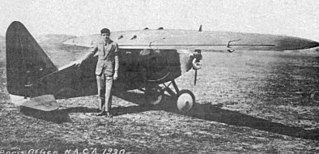
The Aero A.23 was a Czechoslovakian airliner of the 1920s. Aero Vodochody had produced the first Czech airliner, the A.10, four of which had served with ČSA, the national airline. The A.23, another biplane, was bigger, more powerful and could carry more passengers.
The Surrey Flying Services AL.1 was a single-engined side-by-side two-seat training biplane, built at a UK flying club in 1929. Only one was built, but it was flying until the outbreak of war in 1939 and remains in storage.

The Peyret-Mauboussin PM X, PM 4 or Mauboussin M.10 was a low power, single-seat, high wing cantilever monoplane. Only one was built but it set several records in the under 250 kg (550 lb) class both as a landplane and a floatplane.
The IFIL-Reghin RG-4 Pionier or CIL Reghin RG-4 Pionier was a Romanian single seat primary glider built in the 1950s. Fifty were produced.
The Piel CP-40 Donald is a French homebuilt, single engine, single seat, high wing aircraft. It was first flown in the early 1950s, though the last of the three examples completed did not fly until almost forty years later.
The Potez 38 was a French single engine, eight or nine seat passenger aircraft flown in 1930. Only one was built.

The Les Mureaux 3 C.2 and Les Mureaux 4 C.2 were French two seat, parasol winged fighters, flown in 1927-8, which differed only in their engines. They were developed into near identical army co-operation types, the ANF Les Mureaux 130 A.2 and ANF Les Mureaux 131 A.2, in 1929-31.
The Fizir AF-2, Fizir 85 CV or Fizir-Vega was a two-seat amphibian intended for touring, sport and training.

The Caproni Ca.95 was a large, three engine, long range, heavy bomber prototype built in Italy in 1929. It could carry a 1,600 kg (3,500 lb) bomb load and had three defensive gun positions. Only one was built.
The Bassou Rubis (Ruby) was a low power, robust French aircraft designed for basic training and touring.
The Kellner-Béchereau 23 was a French two seat cabin touring aircraft, built in 1932. Its wing was constructed in a novel way. Only one was completed.
The Curtiss-Reid Courier was designed in Canada in 1931 as a specialist, non-passenger carrying, mailplane capable of maintaining services in Canada's hard winters. The 1930s depression led to the end of government subsidised airmail contracts and only one prototype flew. It was lost in 1933 during preparations for a private, long distance flight.

The Dornier Do S was a 22-passenger flying boat airliner flown in Germany in 1930.
The CPA 1 was a French twin-engined, parasol-winged bomber designed and built in the mid-1920s.
The Bulté RB.1 was a Belgian training and touring biplane first flown in 1928. Five examples flew with clubs and with private owners in contests and rallies.

The Działowski D.K.D.1 was the first powered aircraft designed by Stanislaw Działowski. It was a low-power high-wing monoplane with a cabin for one passenger. After attending an aviation exhibition in Warsaw in 1927 it was badly damaged when the engine failed as it left and it did not fly again.

The Rubik R-31 Dupla (Double) was a Hungarian side-by-side seat training glider first flown in 1983. Disappointing performance and vibration problems prevented it going into production.

The 1929 Curtiss Model 53 Condor, also known as the Curtiss Model 53 Condor 18 or the Curtiss CO Condor, was a civil passenger version of the Model 52 Condor bomber. A twin-engined biplane, it carried 18 passengers.

The Lincoln AP was a U.S., single engine, high wing, general purpose civil cabin aircraft first flown in 1930. Only four were built.
The Nicholson Junior KN-2 was a low power, high wing, two seat, cabin monoplane intended for sport or flight training in the United States in the late 1920s. Only one was built.









